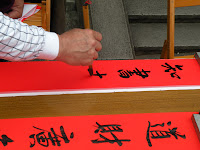One of the best parts of living in a semi-tropical
environment is the incredible variety of year-round delicious fresh
fruits. While some fruits are imported
from distant places, such as Fuji apples from Washington, most of the fruit
comes from Taiwan, China, or the Philippines.
I’ve had to cut myself down to one piece of fruit a day because I
developed the habit of eating kiwis, bananas, mangoes, and apples to satisfy my
frequent cravings for sweets. That is
the downside of the plethora of tree-ripened fresh tropical fruit – too much
accessible sugar. That being said, there
are way worse ways to load up on sweets.
Below are my three Taiwanese favorites.
Custard Apple
aka “Buddha’s Head Fruit”
I don’t know why I have never heard of, let alone tasted,
this amazing fruit. The name gives a
clue to the fruit’s most interesting attribute – a rich and velvety texture
that is reminiscent of cream or custard.
The flavor is somewhere between an apple and a mango, quite sweet and
mildly tropical. While mango has a more
distinct flavor that is unrivaled as an ingredient in smoothies, ice creams,
and candies, the texture of the custard apple is much more satisfying than the
sometimes stringy flesh of a mango.
People call mango the “king of fruits” but I prefer a custard apple any
day over a mango. Maybe it is a good thing that I can't get these at home because I'm not good with moderation. As you can tell from Abel's smile, I'm not alone in my love for this ugly fruit.
Guava
I think I have had guava in the US, but I don’t believe it
is very widely available or recognized.
This is the down-home fruit of Taiwan – cheap and ubiquitous. Initially, I really did not like Guava. The texture is much firmer than most fruit
and the flavor is subtle. When I
realized that there was no escaping the guava, I made an effort to learn to like
the fruit. I made myself eat one daily
for a week, and sure enough by day five or so, I was looking forward to my
daily guava. Part of the conversion to a
guava-fan was learning that there is a huge difference between an almost ripe
and a ripe guava in terms of both flavor and texture. A guava at the peak of ripeness is still
firm, but juicy and sweet. An almost
ripe guava is just plain hard and completely devoid of flavor.
Wax Apple
(according
to Wikipedia, it is also known as . . . love apple, water apple, java apple, royal
apple, bell fruit, and rose apple)
It looks like it is covered in wax, is shaped like a bell or
heart, and has a rosy color, so the long list of names for this fruit are all
quite descriptive. What makes the wax
apple a stand-out at the fruit stand is its texture – very crisp and extremely
juicy (hence the name ‘water apple’).
The flavor is very subtle, which is a euphemistic way to say that it
doesn’t really have much flavor. I have
no idea what wax apple flavored candy or ice cream would taste like. However, the wax apple’s lack of a strong
flavor actually makes it more refreshing.
Think about it as a miniature watermelon with firmer flesh and no seeds –
perfect for a hot Taipei afternoon.
We’ll miss these fruits when we leave Taiwan. I guess we’ll
just have to compensate by drinking the gallons of delicious coffee and pounds
of amazing cheeses that we have at home.
Fair trade.












